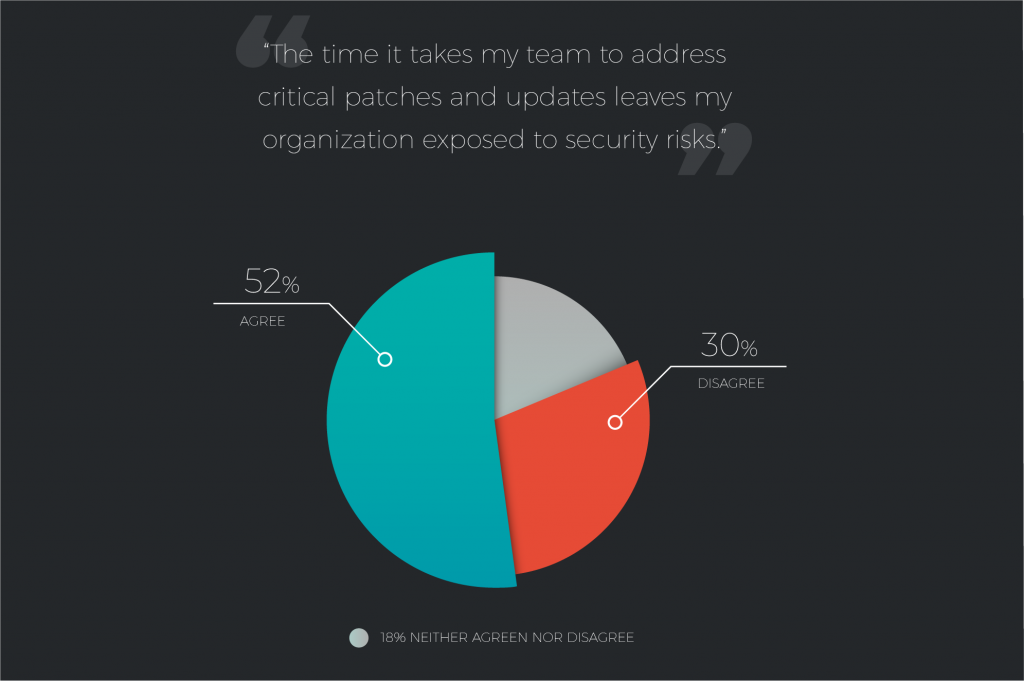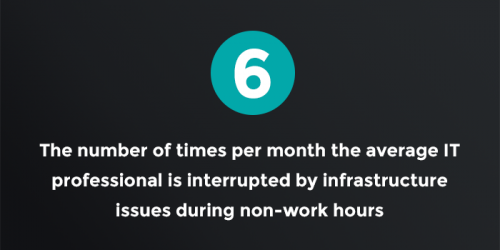
In our latest survey, The State of IT Infrastructure Management, we asked 500 IT professionals to identify what they believe to be IT’s biggest infrastructure challenges for 2019. Here’s how they answered:
- Protecting the organization from cyberattacks
- Migrating applications to the cloud
- Adopting and/or managing a multicloud strategy
- Scaling infrastructure for business growth
- Budget or headcount constraints
- Automating routine processes to increase efficiency/free up internal resources
- Aligning more closely with goals of business units
- Adopting a disaster recovery or business continuity strategy
- Managing outsourcing partners/service providers
- Developing clear project priorities
- Skills shortages hindering key initiatives
- Obtaining quality feedback from end users and customers
Let’s dive a little deeper.
Security
Cybersecurity’s position at the top of the list is unsurprising, given the relentless frequency of high-profile security breaches. And from ransomware to malicious SQL code injections, cyberattacks have been and will continue to be a threat to organizations around the world in 2019.
The ever-expanding threat landscape is putting a major strain on IT professionals. For instance, a majority of survey respondents said that the time it takes their teams to address critical patches and updates leaves their organizations exposed to security risks. As enterprises increasingly move to multicloud IT deployments, maintaining a 360-degree security strategy will only grow more complex.
Cybersecurity may also explain why 1 in 6 IT pros chose “Adopting a disaster recovery or business continuity strategy.” One of IT’s fundamental responsibilities is to maintain operational uptime and high-availability. If a ransomware attack takes a production system down, IT teams must have a failover site in place.
We’ll be diving further into our findings around security in the coming weeks, so stay tuned to the ThinkIT blog.
Adopting a Cloud Strategy
Challenges of the cloud, whether migrating applications to the cloud or adopting and managing a multicloud strategy, follow closely behind security.
So where does one start? Gartner has their seminal “Five Rs” and AWS has six for conceptualizing cloud migration strategies. Whether you’re a fan of Gartner’s Rs or prefer AWS’s, these frameworks both illustrate an important point: Cloud migration requires evaluating between several options and committing to a thoughtful cloud strategy.
This process will look slightly different at each organization, but the first step is the same: determining the right cloud environment for your applications. Starting from the question of what’s best for your applications is the most effective way to ensure your cloud solution provides the best value to your organization.
Once that’s been decided, the process becomes about ensuring you have the right people and processes in place to get the most out of it, managing effective partners (No. 9 on the list), migrating your applications in a way that is minimally disruptive, and then establishing the proper tools to maintain visibility into your environments. This last task is more difficult in a multicloud world where environments are complex and often interconnected, but the challenge is worth it, especially to reap the benefits of scalability that the cloud affords, which brings us to the next top challenge.
Scalability
As businesses grow, workloads grow more intense, and applications must scale up. This makes cloud an “obvious” choice for many. After all, the ability to dynamically scale resources is one of the most commonly touted reasons for migrating to major public cloud providers, especially with the availability of pay-as-you-go options sweetening the pot.
While hyperscale cloud is a powerful option and often a great choice for many, it’s not the only way to access the scalability your organization needs as it grows, and there are other options that can mitigate some of the complexities of managing a multicloud environment.
Hosted private clouds have many of the same benefits as public cloud, with the additional benefit of being right-sized to your applications and resource needs from the start. Plus, it’s easy to spin up new compute and storage resources as your applications require them—with the help of your trusted IT service provider.
Another option is choosing to deploy in a high-density colocation facility, which allows IT organizations to work with their data center partners to make sure they have the capacity to grow within the space, in addition to being in total control of adding resources as needed. High power density environments mean you can harness the same power in a smaller footprint, unlocking even greater potential for growth.
Pivoting Toward Alignment
Budget or headcount restraints, skills shortages, the need to develop clear project priorities and obtain quality feedback from end users and customers: These challenges all speak to IT professionals who want to do more than “keep the lights on” to truly drive innovation and align with the rest of their companies’ business goals but feel hindered from doing so.
This dovetails with two key findings from our survey: 86 percent of respondents agreed with the statement, “My IT department is leading the organization’s digital transformation efforts.” A full 85 percent of IT professionals agreed with the statement, “For my IT department to succeed, we must be seen more as a center of innovation and less as an operational cost center.” [See figure below.]
In the face of being asked to do more with less budget, a lack of skilled staff or unclear priorities, IT is being pulled in two directions.
On one side is the constant need to merely maintain IT systems functionality, an often enormously time-intensive task, and one that still leads to IT professionals being interrupted six times a month on average during non-work hours, according to our survey. On the other is the need to innovate and be more than “just IT.”
This likely explains why 1 in 4 survey respondents say “automating routine processes to increase efficiency and free up internal resources” is a top challenge. Using new tech to offload upkeep is a logical reaction to the resource crunch that IT professionals are faced with.
IT professionals know what they should be doing to create value for the rest of the organization beyond routine IT maintenance and monitoring, and they’re hungry to do so. The challenge is how.







